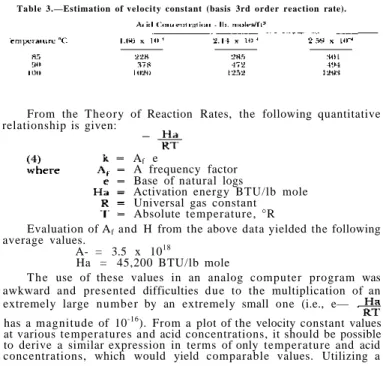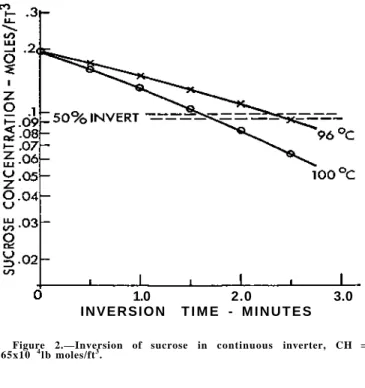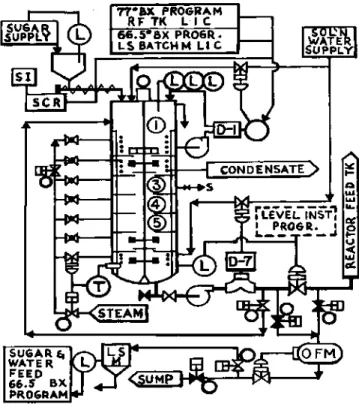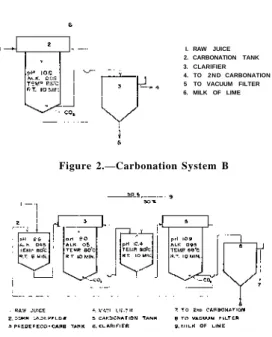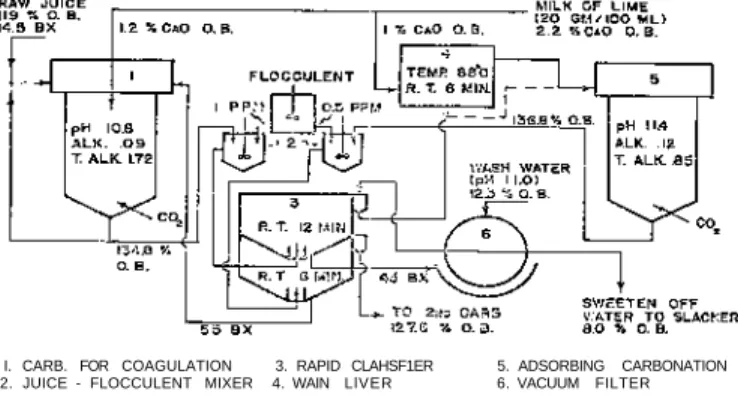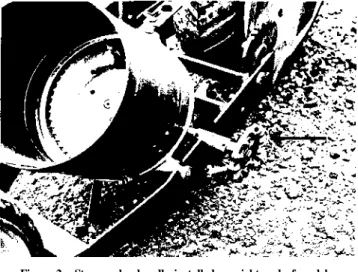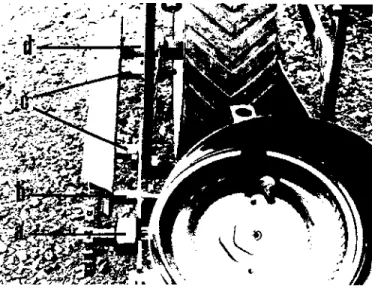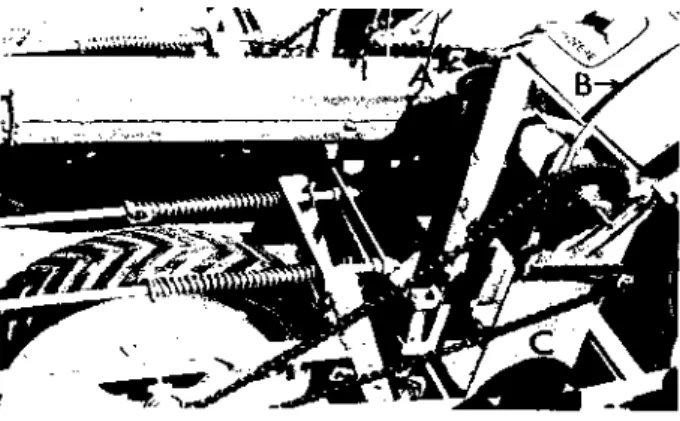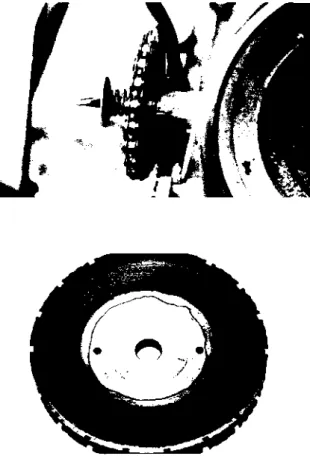This first article covers the concept of the method and laboratory work on the effect of process variables on inversion speed and syrup quality. Tests showed that 46 hours were required to produce a 50% invert syrup by partial inversion of the sucrose syrup at room temperature and 3.3 minutes at 90°C.
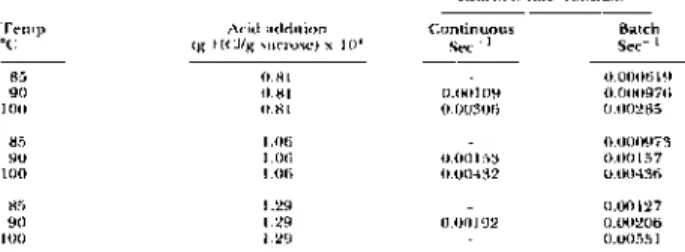
Studies on the Continuous Inversion of Sucrose
II, Application of Research Data
Since the hydrogen ion concentration remains constant during an acid-catalyzed reaction, each of the above rate values can then be converted to its 3rd-order reaction constant by dividing by the hydrogen ion concentration. From a plot of rate constants at different temperatures and acid concentrations, it should be possible to derive a similar expression in terms of temperature and acid concentrations alone, giving comparable values.
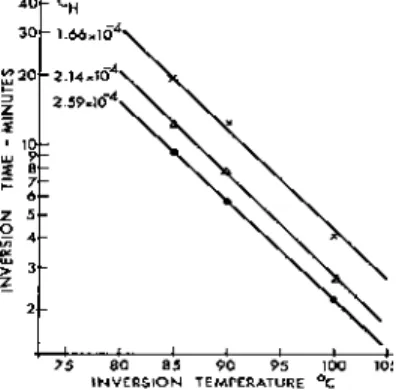
III, Physical Installation
Special wash-out connections are provided to guard against grain formation during layby. (A second flowmeter is used
The stock solution is circulated through the final heater and reactor and back to the reactor feed tank. The drain operation also allows the reactor feed tank level to reach the low condition which causes automatic shutdown of the reactor feed pump.
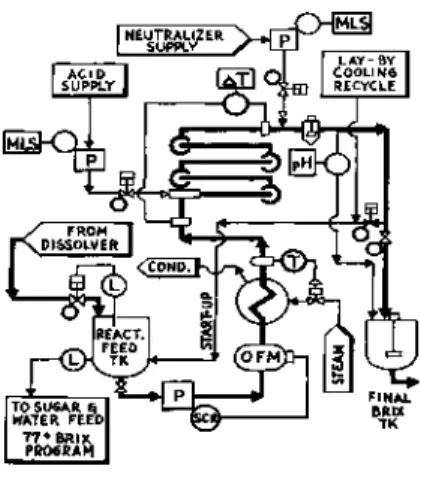
Optimum Carbonation System Design
The values are obtained by treating juice with one ppm flocculent, which is properly prepared and thoroughly mixed with the juice in a measuring cylinder (less than 2.5% CaO O.B., alkalinity values in the CaO range). As a result, maximum benefits can be obtained from the precipitation and separation of colloids in the first stage of carbonation at the optimal alkalinity point from the point of view of improving carbonation elimination.
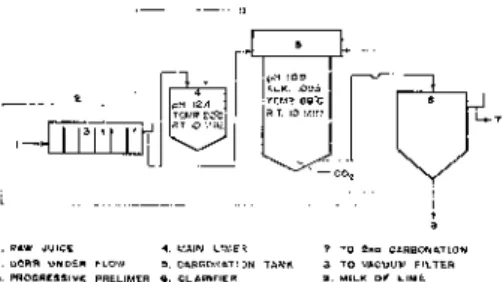
New Planters for Experimental Sugarbeet Plots
2 Mention of any trademark or proprietary product does not constitute a warranty of the product by US. The end of the seed tank drive shaft was turned on a lathe to fit the smaller end of the starter drive. The proximal end of the gear holder was also rotated to fit the larger end of the starter drive.
Holes were drilled through both ends of the starter drive, the end of the seed hopper shaft, and the proximal end of the gear holder. A piece of galvanized pipe attached to the opposite end of the seed hopper shaft extended it to a point outside the planter frame. Mention of a trademark or proprietary product does not constitute a warranty or guarantee of the product by USA.
Cell filling was poor when small amounts (30–60) of seeds were used in stock plates because the seeds rode into the trough of the plate.
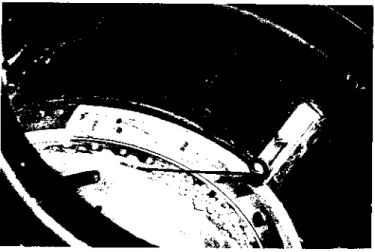
Development of a Methodology for the Production of Aphanomyces cochlioides
Homogenates were prepared essentially by the method described by Gooding and Lucas for the preparation of an oatmeal medium (6), i.e., by grinding the materials in a blender with water for 5 min and then heating the resulting suspension to 50°C. Spore production from cultures maintained continuously in growth media was compared to that from cultures in replacement media. Later, however, cultures maintained in oatmeal medium for approximately 30 days produced more oospores than those in the replacement medium.
Cultures maintained in the synthetic YS medium for a similar period did not show a comparable increase in oospore production. The age of the cultures on which the replacement technique is used has a clear effect on oospor production. Oospore production was compared in media adjusted to a range of pH values from 4.2 to 8.0 with 0.05 N HCl and 0.05 NaOH and with.
Oospore production by isolate Ac-7 in an agar substrate and isolate Ac-9 in a liquid substrate was markedly affected by initial pH of the medium (Table 3).
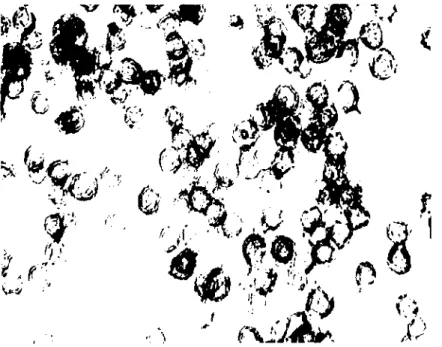
Test 2 4.20
Because the ultimate objective in p o r e in vitro was to use t h e m as inoculum, we accordingly tested their ability to germinate to initiate infection. Beet seedlings were grown in pots with soil infected with oospores of isolate Ac-7 when the seeds were sown. In one experiment, portions of dried mycelial mats from liquid cultures of oospores at various density levels were buried just below the soil surface in the center of each pot.
In a similar experiment, three replicate pots were infected with oospores in dried suspensions on microscope coverslips at densities of approx. Disease incidence increased with an increase in oospore density from 0.7 to 2.6 x 104/pot; no infection was noted in pots with fewer than 0.7 x 104 spores. Inoculum was prepared by grinding oatmeal broth cultures rich in oospores in a blender, mixing the resulting suspension with vermiculite (1:2.5 parts, V:V) and drying it thoroughly.
The relationship between the carbon-nitrogen ratio in the basal medium and sexual reproduction in Phytophthora species.

The Effects of Heterodera schachtii and Aphanomyces cochlioides on Root-rot
The inoculum levels of the two organisms were combined in all combinations to make a 3 x 4 factorial experiment. The rest of the plants in trial 1 and all plants in trial 2 were watered when the soil surface appeared dry. This interaction was a result of the effects of the combination being less than the additive effect of single inoculations.
3The use of trade names is for identification purposes and does not constitute an endorsement or warranty of the product by the USDA, to the exclusion of others of suitable composition. This can be observed by the difference in slope of the curves at a level of 0 to 0.4 larvae/g of soil across the three levels of A. The largest population of cysts resulted from the addition of 2 larvae per g of soil in both experiments. .
Effects of Aphanomyces cochlioides and Pythtum ultimum alone and as complexes with Heterodera schachtii on sugar beet.

Effect of Six Four-Year Rotations on Yield, Quality, and Monetary Return of Sugarbeets
Sugarbeets wheat barley black fallow 2. Sugarbeets wheat barley mixed legume fallow
Sugarbeets wheat barley alfalfa fallow 4. Sugarbeets potato wheat barley
Carrot yields after black fallow (no. 1) were slightly higher than those after m i x e d l e g u m e and alfalfa fallow, but the differences were not significant. Any two means followed by the same letter do not differ at the 5% level according to Duncan's New Multiple R a n g e Test. By adding the average disposable income per acre for the four crops in each rotation, an average annual figure is obtained.
Average four-year net income spent on beets ranged from a low of $143 in the oat rotation to $159 in the barley rotation (No. 4). Beet after three fallow rotations produced about equal income but was slightly lower than three no-fallow rotations. Surrendering land for one year reduces net income ranging from -$16 for mixed legumes to -$6 for the alfalfa rotation.
On the latter, about one ton of alfalfa hay was produced at $18 annually, which offsets part of the fallow costs.

Survey of Sugar Beet Production Practices in Ohio and Their Effect on Sugar Beet Quality
Investigating sugar beet production practices in Ohio and their effect on sugar beet quality.
Survey of sugar beet production practices in Ohio and their effect on sugar beet quality. quartile; however, these differences were not statistically significant. Cultural practice variables examined are given in Table 2. The average date of planting was April 14, associated with the highest yield. Growers in the study averaged a 31 inch row width and cultivated more than 4 times per year.
1).3 More growers in the high yield quartile used herbicides and sprayed for cercospora leaf spot than those in the low yield quartile. Growers in the high yield quartile applied a greater proportion of their nitrogen before planting.
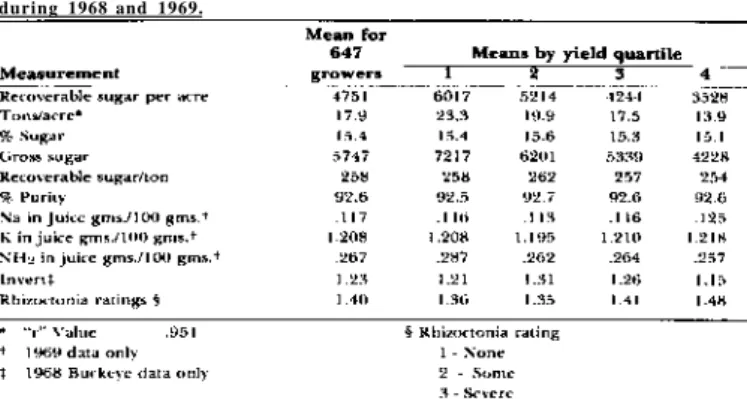
Sugar Beet Production in the Red River Valley as Affected by Population
Roots, tons/acre Sugar, % Sugar, tons/acre Impurity index ratio Roots, tons/acre Sugar, % Sugar, tons/acre Impurity index ratio Roots, tons/acre Sugar, % Sugar, tons/acre Impurity index ratio T h e nitrogen and pc t N l, N 2, N3 and N4. Roots, tons/acre Sugar, % Sugar, tons/acre Impurity index ratio Roots, tons/acre Sugar, % Sugar, tons/acre Impurity index ratio Roots, tons/acre Sugar, % Sugar, tons/acre Impurity index ratio. Water use by sugar beet in a semiarid environment under the influence of population and nitrogen fertilizers.
What is the practical spacing pattern for sugar beets grown in the Red River Valley, Minnesota area.
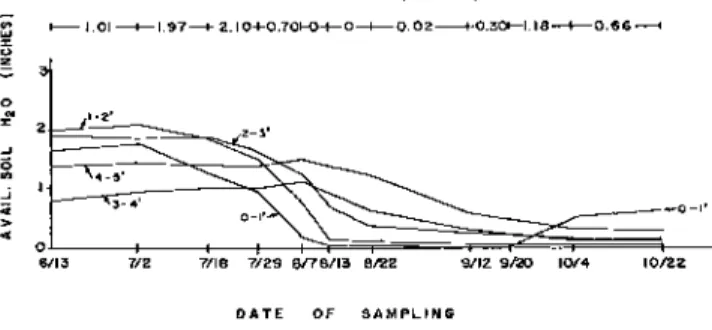
Sugarbeet Growth and Development under Controlled Climatic Conditions with Reference
At the bottom of each container, drainage holes were provided in the polyethylene liner and the pot for adequate flushing of water and nutrients. Nevertheless, good reproducibility of results can be achieved over a 17-week period, so that the effects of climate can be reliably determined, e.g. grow rapidly in the fully controlled environments of plant growth chambers. Effects of night temperature on the growth and development of sugar beet plants grown in plant growth chambers.
Sucrose percentages of the beet roots increased for the four harvest periods with reduced night temperature. T he increases in sucrose percentage due to low night temperatures compensated for the loss in root size that occurred at 2°C in the. In the Phytotron studies, an almost full complement of leaves was produced in an 8-hour photoperiod, but root size was very small and sucrose concentration was only about 3%.
The influence of antecedent climates on the subsequent growth and development of the sugar beet plant.
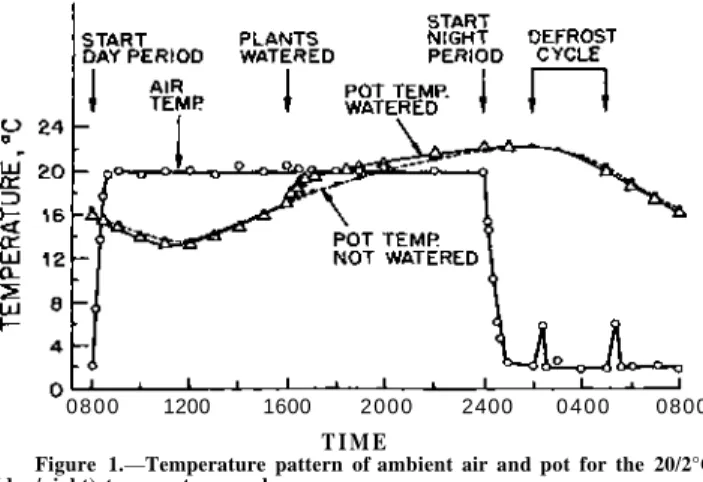
Boron Tolerance of Sugar Beets in Relation to the Growth and Boron Content of Tissues
Boron tolerance of sugar beet in relation to growth and tissue boron content. In the case of sugar beet, the focus should be more on the root of the beet than on the shoot. The rate of photosynthesis must be adversely affected before shoot yield is reduced, so that there is enough sugar produced for tip and fibrous root growth, but not enough for the storage root.
T he boron analysis of the tissues indicates that the yield and the appearance of the leaves are not affected until the B content of the old leaves reaches 600 ppm. In this case, since the injury first affects the old leaves, it is preferable to use the B content of these tissues as an indicator of the status of sugar beet plants from the toxicity point of view. Only a trace of symptoms appeared at 8 ppm and showed as a mosaic chlorosis and cupping of the old leaves.
A final symptom appears as a spot at the tips and edges of the old leaves that moves downward with time as a continuous mass of.

